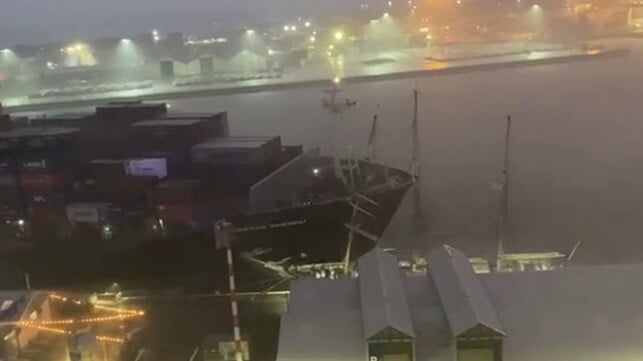Poor Bridge Resource Management Led to Boxship Hitting Tall Ship

Poor bridge resource management was a leading factor in the allision of the Maersk Shekou with the moored tall ship Leeuwin II in Fremantle last year, according to the Australian Transport Safety Bureau.
In the early hours of August 30, 2024, Maersk Shekou was entering Fremantle's harbor with two pilots on the bridge. Conditions were poor, with heavy squalls. The primary pilot assigned for the transit was fatigued, so the backup pilot took charge during the master/pilot exchange. The two pilots conversed casually in English during the transit in, while the rest of the bridge team had separate conversations in another language. Winds were gusty, blowing up to 54 knots. The boxship took up an escort of four assist tugs as it approached the harbor entrance.
At about 0610, as they entered the narrow entrance channel for the inner harbor, southwesterly winds picked up to about 40 knots on the starboard quarter. The helmsman put the rudder over to 30 degrees to port in order to counter the force and maintain heading of 083, but it was insufficient. Through 0615, the pilot gave a series of order to the tug escorts to steady the ship back the its intended course. Once this was accomplished, the helmsman put the rudder to starboard to steady up on the last ordered course of 083 - straight towards a pier. The pilot had forgotten to give a rudder order to turn to port, and the helmsman followed every instruction he had been given.
The pilot and secondary pilot reacted to the impending allision with the pier using a series of engine, bow thruster and tug orders in order to turn to port and bring the ship onto a safe course. The helmsman continued to steer for a steady heading of 083, fighting their efforts. An attempt at an emergency stop was not fully successful, and at about 0618, Maersk Shekou's starboard bow flare hit STS Leeuwin II's rigging, dismasting the tall ship. The Leeuwin's crew abandoned ship onto the pier just as impact occurred, and two sustained minor injuries in the process.
Maersk Shekou's stern kept swinging toward the pier, and the pilots tried to kick it away using the bow thruster and ahead thrust. This was not successful, and a stack of containers on the Shekou's poop deck hit the roof of the Western Australia Maritime Museum. The hull made contact with the pier, resulting in a breach of about six feet long above the waterline.
ATSB found that poor bridge resource management contributed to the casualty. The bridge team did not actively monitor the rate of turn and the helm; they did not conduct proper error management through early challenge and response; and they did not share the same mental model of wheel over points for the transit. In addition, the secondary pilot was engaged in a phone conversation with dispatch at the time of the final turn, and was not monitoring the other pilot, so he was not available to catch the mistake.
Several other lesser factors were at play. The fourth tug was being hooked up in the moments before the missed turn - later than planned - and this may have distracted the team with an unplanned event. The 40-knot squally conditions - outside normal operating parameters for Fremantle's tight harbor - also made the vessel harder to control in the minutes before the turn, adding to the team's workload. The risks of high winds were not considered prior to reaching the passage plan's abort point.
"A properly functioning bridge team requires that all its members maintain a shared mental model to actively monitor the ship’s progress. To ensure this is effective, where deviations from the passage plan are required, this information should be conveyed to all members of the team. Similarly, actions that are incorrect or missed should be immediately identified, communicated and rectified," concluded ATSB.
